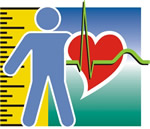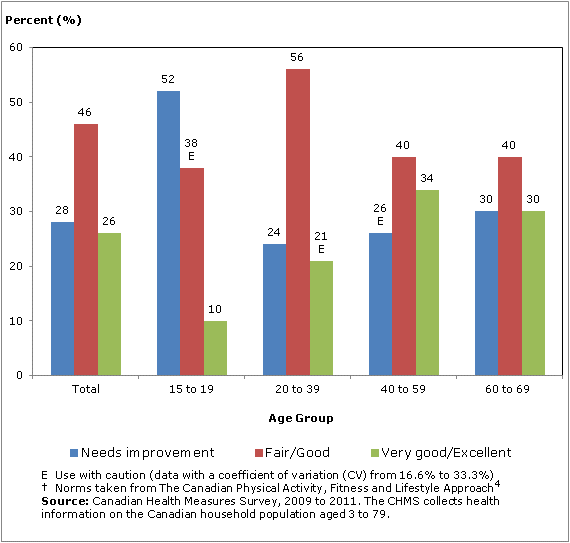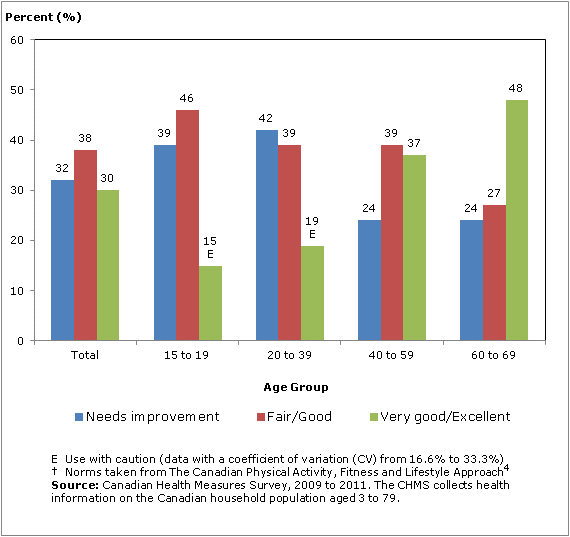Muscular strength of Canadians, 2009 to 2011
Archived Content
Information identified as archived is provided for reference, research or recordkeeping purposes. It is not subject to the Government of Canada Web Standards and has not been altered or updated since it was archived. Please "contact us" to request a format other than those available.

Among Canadians aged 15 to 69, 30% have a grip strength rating that "Needs improvement". For both men and women, a rating of "Needs improvement" was more likely in younger adults than older adults.
Low muscular strength is associated with an increased risk of disability and morbidity, particularly in older people.Note 1 It has also been shown that grip strength can predict mortality in middle-aged and elderly people.Note 2, Note 3
Muscular strength tends to increase from early childhood into adulthood and then declines in middle and late adulthood. For both men and women, muscular strength peaked between the ages of 20 and 59 then significantly decreased.
While younger people had greater actual muscular strength, they were less likely than older people to meet the grips strength norms for their age group. Overall, 28% of Canadian men aged 15 to 69 had muscular strength that "Needs improvement". Men aged 15 to 19 were significantly more likely to have muscular strength that needs improvement than older men. There were no significant differences in the distribution of grip strength norms between men aged 40 to 59 and 60 to 69 (Chart 1).
Chart 1
Distribution of males aged 15 to 69, by grip strength norms† and age group, Canada, 2009 to 2011

Similar to their male counterparts, 32% of Canadian women aged 15 to 69 had muscular strength that "Needs improvement". Women aged 15 to 39 were significantly more likely to have muscular strength that "Needs improvement" than women in other age groups. On the other hand, women aged 40 to 69 were significantly more likely than younger women to have muscular strength that rates "Very good" or "Excellent" (Chart 2).
Chart 2
Distribution of females aged 15 to 69, by grip strength norms† and age group, Canada, 2009 to 2011

About muscular strength
Muscular strength is defined as the maximum tension or force a muscle can exert in a single contraction. The Canadian Health Measures Survey estimated the muscular strength of Canadians aged 6 to 69 through measures of grip strength. Grip strength refers to the maximum force that can be generated by squeezing a handgrip dynamometer and has been shown to be a reliable and convenient measure of an individual's overall muscular strength.Note 4
References
- Sayer AA, Syddall HE, Martin HJ, Dennison EM, Roberts HC, Cooper C. Is grip strength associated with health-related quality of life? Findings from the Hertfordshire Cohort Study. Age and Aging. 2006;35(4):409-15.
- Rantanen T, Harris T, Leveille SG, et al. Muscle strength and body mass index as long-term predictors of mortality in initially healthy men. Journal of Gerontology. 2000;55(33):M168-73.
- Gale CR, Martyn CN, Cooper C, Sayer AA. Grip strength, body composition and mortality. International Journal of Epidemiology. 2007;36(1):228-35.
- Canadian Society for Exercise Physiology (CSEP). The Canadian Physical Activity, Fitness and Lifestyle Approach. 3rd ed; 2003
For more information on the Canadian Health Measures Survey, please contact Statistics Canada's National Contact Centre (toll-free 1-800-263-1136; 613-951-8116; infostats@statcan.gc.ca).
- Date modified:
